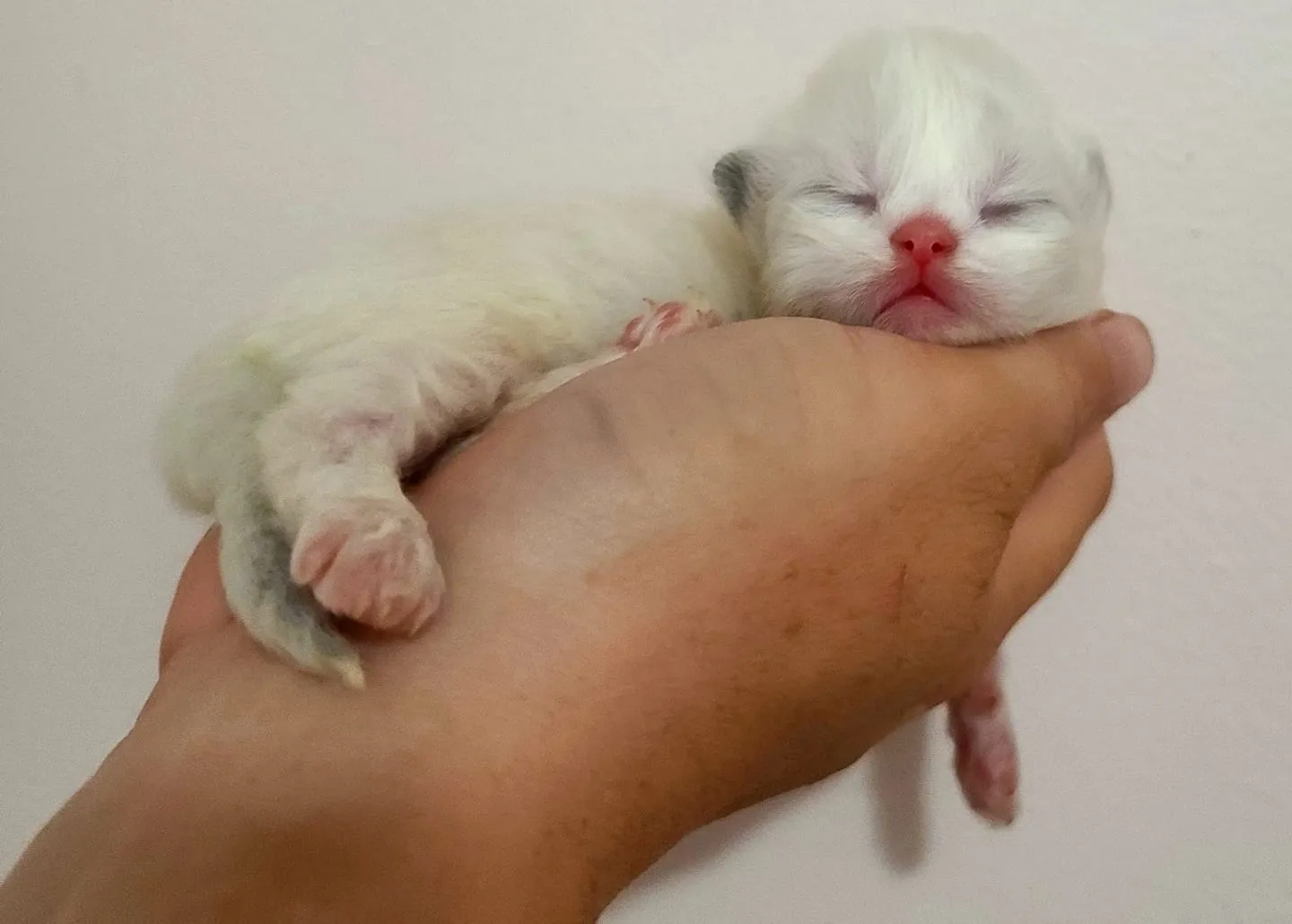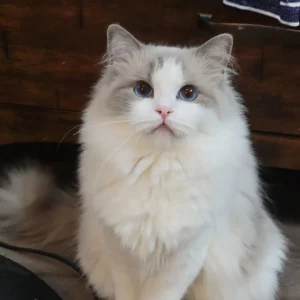Breed Information
The Ragdoll is a cat breed with blue eyes and a distinct colour point coat. It is a large and muscular semi-longhair cat with a soft and silky coat. Like all long haired cats, Ragdolls need grooming to ensure their fur does not mat. Developed by American breeder Ann Baker in the 1960s, it is best known for its docile and placid temperament and affectionate nature. The name “Ragdoll” is derived from the tendency of individuals from the original breeding stock to go limp and relaxed when picked up. Ragdoll cats often are known as “dog-like cats” or “puppy-like cats” due to behaviors such as their tendency to follow people around, their ease at being physically handled, and their relative lack of aggression toward other pets
The laidback Ragdoll is perfectly suited to family life. He rarely extends his claws when playing. Males are an especially good choice for families with children because of their large size. Of course, you should always supervise young children to make sure they don’t torment the cat. And with a cat this size, it’s essential to teach children how to support the cat, with one arm beneath the front legs and one beneath the hind legs. Never hold a Ragdoll with the hind end hanging down. He is happy to live with other cats and cat-friendly dogs, too, thanks to his amiable disposition. Introduce pets slowly and in controlled circumstances to ensure that they learn to get along together.
The Ragdoll is one of the Larger Domestic Cats with Males weighing from 14 to 20 pounds and Females weighing from 8 to 14 pounds. Although larger cats Ragdolls are gentle, docile and extremely sociable. They make wonderful companions for the young and old. They get their distinctive name Ragdoll from the ability to go limp while being cradled on their backs. I find this especially true of the kittens who love to be lavished with attention while in this position.
The traditional Ragdoll colors are Seal, Blue, Chocolate and Lilac. True Chocolate and Lilac are dilute versions of Seal and Blue. There are many shades of seal and Blue, often the lighter versions are mistaken as Chocolate and Lilac and thus registered as such. This is especially true of bi colors having no color on their nose or foot pads. The newer colors include Cream, Flame, Seal Torties and Blue Cream. Ragdolls come in “3” patterns. These are the Color Point, the Mitted and the Bicolor.
The color points are darker on the ears, face, legs and tail . The Mitted are darker on the ears, tail, face with the exception of two front legs having two white mitts and two white back legs. The bi colors are darker on the ears, tail, face with a white upside down V centered between the eyes, and the legs. Belly, chest and chin are white.
Another unique feature about the Ragdoll is even though long haired, they have a relatively non-matting, low maintenance coat. They love to be brushed but often need little grooming. It is almost like a rabbit type feel.
Colors and Patterns
We are often asked for an example of color or patterns when people are looking to adopt one of our kittens
I have added photos below for better understanding of colors
Patterns
Bi color – Mitted – Colorpoint
Colors
Blue – Seal – Flame – Cream – Tortie – Torbie – Chocolate (we dont breed) – Lilac (we do not breed)
Other Markings
Lynx (tabby) – blaze
Bi-Color
A BI-COLOR PATTERN INCLUDES THE FOLLOWING DEFINITIONS:
- Points: restricted to ears, tail, mask and shading on the ‘saddle’ area.
- Mask: white inverted “V” remains within outer edge of eyes. Symmetry preferred.
- Nose Leather: pink.
- Body: chin, chest, and underside are white. Upper body may show white spotting.
- Legs and Feet: all white preferred. May have minor dark spots.
- Paw Pads: pink preferred, but mixture of colors on paw pads and fur acceptable because of two colors in pattern.
- When determining color, point color of ears is the deciding factor

BLUE BI COLOR
light grey to a darker grey blue

SEAL BI COLOR
Seal (Dark Brown) color points

BLUE TORTIE BI COLOR
Blue Torties are simular to the blue color however they ALSO have cream in their points.

SEAL TORBIE BI COLOR
Can come in blue bi color variation too
A TORBIE color is seal or blue WITH Orange/Cream AND LYNX markings ( the stripes)

BLUE LYNX BI COLOR
Same as Blue bi colors with LYNX (Tabby) Patterns

SEAL LYNX BI COLOR
Same as seal bi color but has LYNX (Tabby) Markings


FLAME BI COLOR
USUALLY MALE BUT CAN BE FEMALE IF THE BREEDER BREEDS FOR THIS (WHICH WE DO!)
Flame (red markings)
CREAM is similar
Mitted
A MITTED PATTERN INCLUDES THE FOLLOWING DEFINITIONS:
- Points: legs (except for feet), ears, mask, and tail well-defined. May have a white blaze in the shape of a star, diamond, hour-glass or line in one patch or broken, centrally and symmetrically located anywhere from the top of the nose leather to the forehead.
- Chin: must be white and extend into white belly stripe.
- Front Feet: white mittens present on both feet, evenly matched, preferably going up to and around the wrist joint. Back legs: white must go up to and around the hocks entirely, extending no higher than mid-thigh.
- Nose Leather: fully pigmented and matching point color. Paw pads: pink but may show minor spotting of color corresponding to point color.
- Body: definite contrast between body and points. There should be a white belly stripe, varying in width from the bib, between the forelegs down the midline of the underside of the cat. Soft shadings of color are allowed on body.
- Allowance to be made for faint ghost markings on kittens.
- Full color achieved after 2 years of age.

BLUE MITTED
Light grey to blue grey color points

SEAL MITTED
Very dark brown color on it’s points

FLAME MITTED
USUALLY MALE BUT CAN BE FEMALE IF THE BREEDER BREEDS FOR THIS (WE DO)
Flame ( Red )

BLUE LYNX MITTED
Same as the blue mitted but has LYNX (Tabby) markings

BLUE TORTIE MITTED
ALWAYS FEMALE
Same as the blue mitted but with cream in their color points

SEAL TORTIE MITTED
ALWAYS FEMALE
Seal and flame color points
Same as seal mitted WITH flame ( orange )

SEAL LYNX MITTED
Same as the seal mitted but has LYNX (Tabby) Markings

SEALTORBIE MITTED
DOES COME IN BLUE ALSO, STILL LOOKING FOR A PAST PHOTO OF ONE TO SHARE.
Same as a seal lynx mitted but also has flame ( orange )

BLUE TORBIE MITTED
Blue/Cream mitted WITH lynx


CREAM MITTED
USUALLY MALE BUT CAN BE FEMALE IF THE BREEDER BREEDS FOR THIS (WE DO)
Lighter (softer) than a flame
The best way I can desribe this is:
The dilute of flame or red- meaning if they were seal and blue, the cream would be the blue and the seal would be the flame.
Color Point
A COLORPOINT PATTERN INCLUDES THE FOLLOWING DEFINITIONS:
- Points: ears, mask, feet and tail to be darker, with well-defined color.
- Nose Leather and Paw Pads: fully pigmented and matching point color.
- Body: definite contrast between body and points, chest, bib and chin areas may be somewhat lighter in color
- COME IN ALL COLORS
BLUE POINT
grey or blue/ grey tones on all points and body. Darker on face, ears,tails and legs

SEAL POINT
Dark brown color points on points. Darker tones on face, ears, tail and legs

BLUE LYNX POINT
light grey / blue grey color points with LYNX ( Tabby ) markings. Darker on face, ears, legs and tail.

SEAL LYNX POINT
Seal color point with LYNX ( Tabby ) markings, Darker on face, ears tail and legs.

SEAL TORTIE POINT
Same as seal point LYNX (Tabby) WITH flame (orange).

